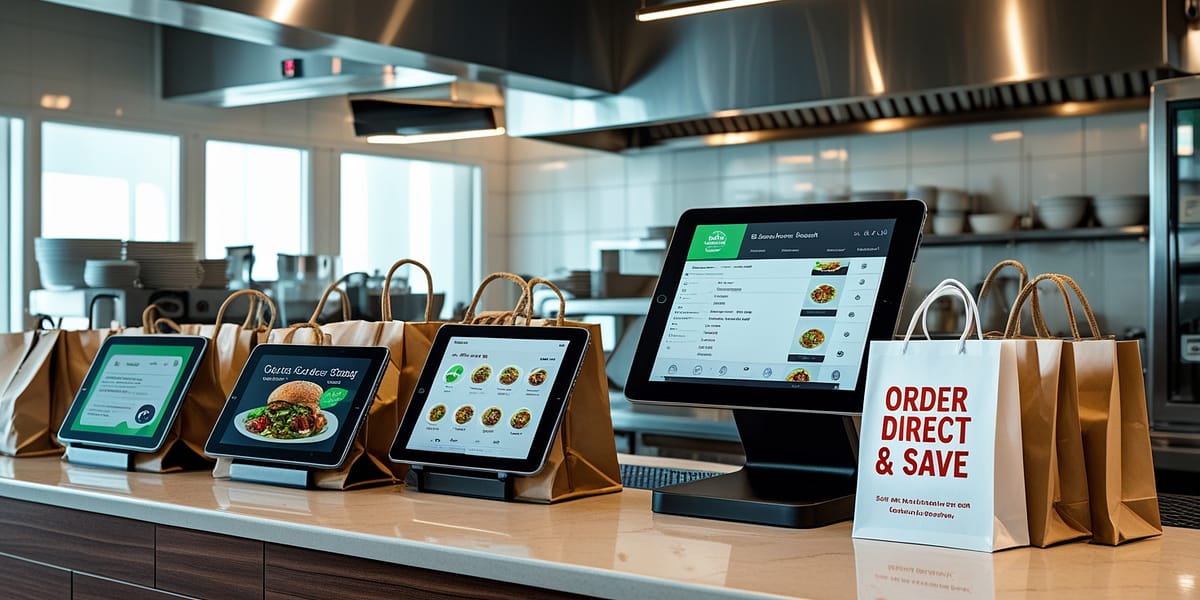Beyond the Aggregators: Why Over-Reliance on Delivery Apps is Holding Your Dubai Restaurant Back
Let me start with something that might sound controversial in today’s F&B world, especially here in the hyper-competitive Dubai market: Your intense focus on maximizing orders through third-party delivery aggregators might be slowly eroding the long-term health and value of your restaurant.
There, I said it.
Look, I get it. Delivery apps are convenient lifelines. They offer reach, a ready-made ordering platform, and access to customers you might not otherwise capture. In a dynamic city like Dubai, where convenience is king, they certainly play a role. Many restaurants feel they have to be on multiple platforms just to stay visible.
But here’s the uncomfortable truth: over-reliance on these platforms is a dangerous game. While you’re busy fulfilling orders generated through them, you might be neglecting the single most valuable asset your restaurant possesses: your direct relationship with your own customers.
As someone who has spent a lot of time talking to restaurant owners across Dubai and the UAE, I see firsthand the operational challenges and the constant pressure on margins. And I see how an unbalanced reliance on aggregators contributes to these struggles in ways that aren’t immediately obvious.
Here’s why chasing those aggregator orders, while seemingly necessary, needs a strategic rethink:
1. You’re Giving Away Your Customer & Their Data
When an order comes through an aggregator, who owns the customer relationship? Not you. The platform does. They have the contact details, the order history, the preferences. You often get little more than an order ticket. This means:
- No Direct Marketing: You can’t easily re-engage them with special offers, loyalty programs, or news about your restaurant.
- No Personalization: You lose the ability to tailor experiences or promotions based on their past behaviour.
- Building Their Brand, Not Yours: Customers become loyal to the convenience of the app, not your restaurant.
Your Point-of-Sale (POS) system should be the heart of your customer data, enabling targeted marketing and loyalty. When the majority of your off-premise orders bypass this, you’re flying blind.
2. Margin Erosion is Real and Painful
This is the most obvious point, but it bears repeating. Commission fees from major aggregators can range from 15% to upwards of 30%. In an industry with already tight margins, this is significant. Calculate what that equates to over a year – it’s often staggering.
Furthermore, the pressure to participate in app-wide discounts can squeeze margins even further, forcing you to potentially compromise on quality or absorb losses.
3. You Lose Control Over Brand Experience
Your restaurant isn’t just about the food; it’s about the entire experience. When you rely solely on aggregators for delivery:
- Brand Dilution: Your meticulously crafted brand becomes just another thumbnail in a crowded marketplace.
- Inconsistent Delivery Experience: You have little control over the delivery driver’s professionalism, the delivery time, or how your food is presented upon arrival.
- Packaging Limitations: Your ability to use unique, brand-reinforcing packaging might be limited by aggregator standards or practicalities.
4. Operational Headaches (Without Proper Integration)
Remember the days of multiple tablets cluttering the counter, staff frantically re-punching orders into the POS, increasing the risk of errors and delays? While POS integration (like what we focus on at iPOS) solves this specific issue, the fundamental reliance still means you’re operating within the constraints and technical framework dictated by the aggregator.
So, What’s the Alternative? Ditch the Apps Entirely?
No, not necessarily. The solution isn’t usually about completely abandoning delivery apps – they are a powerful acquisition channel. The key is rebalancing your strategy and prioritizing direct channels.
- Invest in Your Own Direct Ordering: Develop or enhance your own website or branded mobile app for direct orders. Make it seamless and user-friendly.
- Incentivize Direct Orders: Offer small discounts, exclusive menu items, or loyalty points for customers who order directly from you.
- Leverage Your POS/CRM: Use customer data from your POS for dine-in and direct orders. Build email lists, run SMS campaigns, and reward loyalty.
- Own the Experience: Consider handling your own delivery for nearby orders to maintain control. Or work with reliable partners where you manage the relationship.
- Use Apps for Discovery, Convert to Direct: Include a flyer in aggregator orders encouraging customers to order directly next time.
The Takeaway
Delivery apps are a tool—not your entire off-premise strategy. Building a sustainable, profitable restaurant business in Dubai requires owning your customer relationships, controlling your brand experience, and protecting your margins.
Beyond the Aggregators: Why Over-Reliance on Delivery Apps is Holding Your Dubai Restaurant Back
Hook: Let me start with something that might sound controversial in today’s F&B world, especially here in the hyper-competitive Dubai market: Your intense focus on maximizing orders through third-party delivery aggregators might be slowly eroding the long-term health and value of your restaurant.
There, I said it.
Look, I get it. Delivery apps are convenient lifelines. They offer reach, a ready-made ordering platform, and access to customers you might not otherwise capture. In a dynamic city like Dubai, where convenience is king, they certainly play a role. Many restaurants feel they have to be on multiple platforms just to stay visible.
But here’s the uncomfortable truth: over-reliance on these platforms is a dangerous game. While you’re busy fulfilling orders generated through them, you might be neglecting the single most valuable asset your restaurant possesses: your direct relationship with your own customers.
As someone who has spent a lot of time talking to restaurant owners across Dubai and the UAE, I see firsthand the operational challenges and the constant pressure on margins. And I see how an unbalanced reliance on aggregators contributes to these struggles in ways that aren’t immediately obvious.
Here’s why chasing those aggregator orders, while seemingly necessary, needs a strategic rethink:
1. You’re Giving Away Your Customer & Their Data
When an order comes through an aggregator, who owns the customer relationship? Not you. The platform does. They have the contact details, the order history, the preferences. You often get little more than an order ticket. This means:
- No Direct Marketing: You can’t easily re-engage them with special offers, loyalty programs, or news about your restaurant.
- No Personalization: You lose the ability to tailor experiences or promotions based on their past behaviour.
- Building Their Brand, Not Yours: Customers become loyal to the convenience of the app, not your restaurant.
Your Point-of-Sale (POS) system should be the heart of your customer data, enabling targeted marketing and loyalty. When the majority of your off-premise orders bypass this, you’re flying blind.
2. Margin Erosion is Real and Painful
This is the most obvious point, but it bears repeating. Commission fees from major aggregators can range from 15% to upwards of 30%. In an industry with already tight margins, this is significant. Calculate what that equates to over a year – it’s often staggering.
Furthermore, the pressure to participate in app-wide discounts can squeeze margins even further, forcing you to potentially compromise on quality or absorb losses.
3. You Lose Control Over Brand Experience
Your restaurant isn’t just about the food; it’s about the entire experience. When you rely solely on aggregators for delivery:
- Brand Dilution: Your meticulously crafted brand becomes just another thumbnail in a crowded marketplace.
- Inconsistent Delivery Experience: You have little control over the delivery driver’s professionalism, the delivery time, or how your food is presented upon arrival.
- Packaging Limitations: Your ability to use unique, brand-reinforcing packaging might be limited by aggregator standards or practicalities.
4. Operational Headaches (Without Proper Integration)
Remember the days of multiple tablets cluttering the counter, staff frantically re-punching orders into the POS, increasing the risk of errors and delays? While POS integration (like what we focus on at iPOS) solves this specific issue, the fundamental reliance still means you’re operating within the constraints and technical framework dictated by the aggregator.
So, What’s the Alternative? Ditch the Apps Entirely?
No, not necessarily. The solution isn’t usually about completely abandoning delivery apps – they are a powerful acquisition channel. The key is rebalancing your strategy and prioritizing direct channels.
- Invest in Your Own Direct Ordering: Develop or enhance your own website or branded mobile app for direct orders. Make it seamless and user-friendly.
- Incentivize Direct Orders: Offer small discounts, exclusive menu items, or loyalty points for customers who order directly from you.
- Leverage Your POS/CRM: Use customer data from your POS for dine-in and direct orders. Build email lists, run SMS campaigns, and reward loyalty.
- Own the Experience: Consider handling your own delivery for nearby orders to maintain control. Or work with reliable partners where you manage the relationship.
- Use Apps for Discovery, Convert to Direct: Include a flyer in aggregator orders encouraging customers to order directly next time.
The Takeaway
Delivery apps are a tool—not your entire off-premise strategy. Building a sustainable, profitable restaurant business in Dubai requires owning your customer relationships, controlling your brand experience, and protecting your margins.
Beyond the Aggregators: Why Over-Reliance on Delivery Apps is Holding Your Dubai Restaurant Back
Hook: Let me start with something that might sound controversial in today’s F&B world, especially here in the hyper-competitive Dubai market: Your intense focus on maximizing orders through third-party delivery aggregators might be slowly eroding the long-term health and value of your restaurant.
There, I said it.
Look, I get it. Delivery apps are convenient lifelines. They offer reach, a ready-made ordering platform, and access to customers you might not otherwise capture. In a dynamic city like Dubai, where convenience is king, they certainly play a role. Many restaurants feel they have to be on multiple platforms just to stay visible.
But here’s the uncomfortable truth: over-reliance on these platforms is a dangerous game. While you’re busy fulfilling orders generated through them, you might be neglecting the single most valuable asset your restaurant possesses: your direct relationship with your own customers.
As someone who has spent a lot of time talking to restaurant owners across Dubai and the UAE, I see firsthand the operational challenges and the constant pressure on margins. And I see how an unbalanced reliance on aggregators contributes to these struggles in ways that aren’t immediately obvious.
Here’s why chasing those aggregator orders, while seemingly necessary, needs a strategic rethink:
1. You’re Giving Away Your Customer & Their Data
When an order comes through an aggregator, who owns the customer relationship? Not you. The platform does. They have the contact details, the order history, the preferences. You often get little more than an order ticket. This means:
- No Direct Marketing: You can’t easily re-engage them with special offers, loyalty programs, or news about your restaurant.
- No Personalization: You lose the ability to tailor experiences or promotions based on their past behaviour.
- Building Their Brand, Not Yours: Customers become loyal to the convenience of the app, not your restaurant.
Your Point-of-Sale (POS) system should be the heart of your customer data, enabling targeted marketing and loyalty. When the majority of your off-premise orders bypass this, you’re flying blind.
2. Margin Erosion is Real and Painful
This is the most obvious point, but it bears repeating. Commission fees from major aggregators can range from 15% to upwards of 30%. In an industry with already tight margins, this is significant. Calculate what that equates to over a year – it’s often staggering.
Furthermore, the pressure to participate in app-wide discounts can squeeze margins even further, forcing you to potentially compromise on quality or absorb losses.
3. You Lose Control Over Brand Experience
Your restaurant isn’t just about the food; it’s about the entire experience. When you rely solely on aggregators for delivery:
- Brand Dilution: Your meticulously crafted brand becomes just another thumbnail in a crowded marketplace.
- Inconsistent Delivery Experience: You have little control over the delivery driver’s professionalism, the delivery time, or how your food is presented upon arrival.
- Packaging Limitations: Your ability to use unique, brand-reinforcing packaging might be limited by aggregator standards or practicalities.
4. Operational Headaches (Without Proper Integration)
Remember the days of multiple tablets cluttering the counter, staff frantically re-punching orders into the POS, increasing the risk of errors and delays? While POS integration (like what we focus on at iPOS) solves this specific issue, the fundamental reliance still means you’re operating within the constraints and technical framework dictated by the aggregator.
So, What’s the Alternative? Ditch the Apps Entirely?
No, not necessarily. The solution isn’t usually about completely abandoning delivery apps – they are a powerful acquisition channel. The key is rebalancing your strategy and prioritizing direct channels.
- Invest in Your Own Direct Ordering: Develop or enhance your own website or branded mobile app for direct orders. Make it seamless and user-friendly.
- Incentivize Direct Orders: Offer small discounts, exclusive menu items, or loyalty points for customers who order directly from you.
- Leverage Your POS/CRM: Use customer data from your POS for dine-in and direct orders. Build email lists, run SMS campaigns, and reward loyalty.
- Own the Experience: Consider handling your own delivery for nearby orders to maintain control. Or work with reliable partners where you manage the relationship.
- Use Apps for Discovery, Convert to Direct: Include a flyer in aggregator orders encouraging customers to order directly next time.
The Takeaway
Delivery apps are a tool—not your entire off-premise strategy. Building a sustainable, profitable restaurant business in Dubai requires owning your customer relationships, controlling your brand experience, and protecting your margins.
Stop letting third-party platforms dictate your future. It’s time to take back control, leverage your own technology like your POS system intelligently, and invest in building lasting, direct connections with the people who truly love your food. That’s where the long-term value lies.






Comments
Be the first to comment on this article.